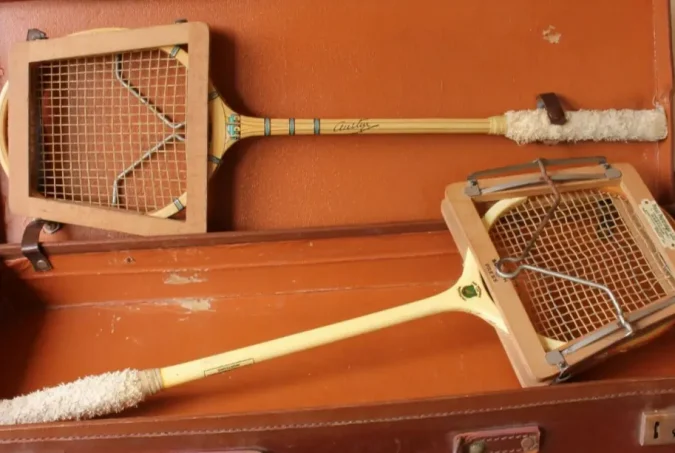25 July 2022 / 3-Min Read / Translate
Wooden rackets were heavy and very susceptible to moisture. Over time the racket head would warped if it were not stored in a cool and dry place. In this context “warp” means to lose its alignment. If you were to place the racket on the floor flat, it wouldn’t touch the floor evenly. One side would be higher than the other. I looked for photos on the internet but couldn’t find one and luckily all my wooden rackets are not warped.

A beautiful leather case with two rackets and presses
Back in the 1970’s, when you bought an expensive wooden racket, they might even come with a presses, although it was often bought separately or you used the one from your previous racket. I never owned one back in the day, because I always broke a racket before it had time to warp and my rackets were cheaper than the press! I’m not sure if that was a good or bad thing!

3 different racket press designs
The image above shows the 3 main designs. The first one, almost square, but not quite, was the easiest to use as it utilised the metal bar you see with the hook shape. You placed the racket inside, then “flipped” the metal bar to the other end and it clamped the racket in place. The two other designs required you to unscrew the wing nuts and slip the racket inside. You then had to screw each wing nut again – very time consuming! I think my favourite design is the triangular ones, which I much rare than the three designs above.
Most professional squash players didn’t bother with them because they greatly increased the weight and bulk of carrying multiple rackets around and being sponsored, they didn’t really care if the racket warped as they would just get another bunch supplied. There’s a great photo of a group of Pakistani squash players standing around some with 6 or 7 rackets in their arms. I looked high and low for the photo but couldn’t find it. If I ever do, I’ll update this article and add it. If you know the photo I mean, please tell send it to me!
Most amateurs would put their rackets inside their squash bag, which almost certainly had their stinky, wet kit inside and that probably made more rackets warp than anything. To my knowledge, that’s one of the reasons why racket manufacturers started making specific racket bags. They wanted to keep the rackets away from the kit. You’ll notice that many racket bags have a silver lining inside – this is supposed to keep the moisture away.
Of course, nowadays, that’s not needed unless you travel a lot with natural gut in your strings, in which case keep your rackets in the silver-lined section might help. Most of use keep our rackets in the wrong pocket section anyway!
It wasn’t only squash rackets that needed the presses but tennis and badminton too. The squash and badminton was inter-changable for the most part, whereas you needed a bigger one for a tennis racket. The final thing I want to mention are the solid wooden presses. These are quite rare and I believe were the original design. You can see some in the image below.

Make sure you have plenty of spare cash if you want one of these!
What’s interesting about the racket presses above is that some of them could hold more than one racket. You can see by the bolts that it would have been possible to have about 3 or 4, which would have made the whole thing very awkward to carry – of perhaps your servant would have carried it anyway!
Curious about the prices? Well, the standard square wooden ones can be bought for under 10 Pounds, sometimes including a racket. The cross style are a little more expensive and the aluminium can sell for about 50 Pounds. The solid wooden ones sell for well over 100 Pounds if they are in good condition and made of mahogany.